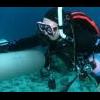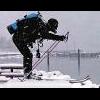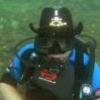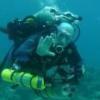
Live Boating / Drift Diving:
#1

Posted 20 September 2009 - 09:12 AM
Re-printed from Dive Training Magazine August 2009 issue, authored by Lynn Layman
How are your boat diving skills? If you're like many divers certified in North America it's likely you did your Open Water training dives from shore. If so, you gained valuable experience at shore entries and exits, but didn't have the opportunity to dive from a boat.
There are two types of boat dives: from stationary boats and from unanchored boats. A stationary boat is one that has either set an anchor or is attached to a mooring. Unless the anchor drags or the mooring line breaks, the boat will remain tethered in the same relative location.
Divers enter the water from the boat, conduct the dive in the vicinity of the boat and then surface and reboard without the vessel moving. Since the boat is tethered in one location it is the divers' responsibility to remain nearby and find their way back to the boat.
An unanchored boat is just what the name implies -- a vessel that has neither set an anchor nor is attached to a mooring; the boat floats unsecured, free to maneuver at the captain's discretion. With few exceptions, drift diving is the typical method of diving from an unanchored boat. Divers enter the water from the drifting vessel, descend and let the current -- sometimes strong, other times mild to nonexistent -- carry them along. The boat follows close by, often keying on the divers' bubbles breaking the surface or a surface marker buoy towed by the divemaster. The divers don't worry about finding the boat; when they surface it comes to them.
Occassionally the captain will anchor the boat or tie to a mooring so divers can enter and descend using a stationary reference. Once they reach diving depth, the crew pulls the anchor or releases the mooring and follows the divers' bubbles or surface marker buoy.
Entering the Water
Generally there is no urgency about entering the water quickly when diving from an anchored vessel; the boat isn't going anywhere and you will return to it at the end of the dive. Live boating is different. Sometimes the term "live boat" is associated with an unanchored vessel whose engine(s) is running, as compared with an unanchored vessel that is adrift with the engine not running. For the purpose of this article, which describes the skills used when diving from an unanchored boat, we do not differentiate between engine running and not running.
When diving from an unanchored boat, speed and efficiency of entry and exit are important. Unless instructed otherwise by the boat crew, all gear should be assembled, tested and staged for donning well before the boat arrives at the dive site.
Typically, the divemaster presents the predive briefing and advises divers to begin donning exposure protection several minutes before the boat reaches the site. Once there, divers are instructed to don their scuba units as the captain maneuvers the vessel slightly upcurrent from where the divers are to enter. Divers then queue up in preparation for entering the water in efficient, typically rapid succession. Sometimes the boat engine(s) is turned off just before the divers are instructed to begin entering the water; however, more often the engine is left running. The boat's propellers are disengaged -- taken out of gear -- prior to anyone entering the water.
Under the watchful eyes and support of the boat crew the divers are staged for entry. Once the boat is positioned over the entry location, the crew gives the "OK" to shuffle sideways to the swim platform and perform a giant stride entry [or backroll, depending on the boat! LLDN]. It is important that the divers move efficiently and enter in succession. The exact technique used depends on the boat layout, current and surface conditions. The predive briefing will include the procedure to be followed, so it's especially important to listen carefully to the dive briefing.
Divers with an underwater camera either enter with it in their hands or have a crewmember pass it to them after entering. When returning for a camera, always approach the side of the entry area to avoid interfering with other divers entering the water. Once in the water, divers without a camera should signal the boat crew that they are "OK" and quickly move away from the entry area so other divers can enter.
The Descent
When diving from a live boat, divers often descend as a group; this is especially important when participating in a guided dive. After entering and moving away from the entry area, divers typically gather on the surface, as instructed during the predive briefing. When all divers are in the water the divemaster instructs the group to descend.
When the "descend" signal is given, all divers should immediately vent the air from their buoyancy compensator, equalize and descend. Dive buddies should stay together and with the other divers, expecially when current exists.
Due to water conditions and reef/wall configurations at some dive destinations, rather than wait on the surface for all divers to enter, buddies enter in rapid succession and descend immediately. The group then rendezvous at diving depth. When instructed to use this technique use caution to avoid being carried away by the current before regrouping at diving depth.
At Depth
Once at depth live boat diving is the most effortless diving you'll find -- drift diving; divers go with the flow while the boat follows on the surface. When divers stay together it is easier for the boat crew to keep track of everyone's whereabouts. Other than that, it is a carefree, effortless dive.
When drifting along a wall the typical profile begins near the planned maximum depth and slowly moves shallower as the dive progresses. By the end of the dive you often end up near safety-stop depth.
On guided dives often the divemaster will tow a surface marker buoy throughout the dive; this gives the boat crew a continuous reference to follow. Even so, each diver should be equipped with his own inflatable surface marker buoy, in case he becomes separated from his buddy and other divers or surfaces a distance from the boat.
Safety Stops
When drift diving from a live boat divers typically continue drifting with the current throughout the safety stop. When not guided, one diver in the group typically deploys his surface marker buoy while ascending to safety stop depth. This helps the boat crew pinpoint the divers' exact position. Throughout the safety stop all divers in the group should stay within about 15-20 feet of the diver towing the marker buoy.
At the end of the safety stop, the divers slowly and cautiously surface [then inflate their BC] and wait to be picked up by the boat. All divers whose location is marked by the buoy should make the final ascent together and then stay together on the surface. Remaining below the surface as the boat approaches is dangerous because you are not visible to the crew.
On the Surface
Once all the divers in a group are floating comfortably on the surface, the dive guide or one of the group signals the boat crew that everyone is on the surface and that it is safe for the boat to approach. At that point the boat crew takes control of directing the divers.
A crewmember typically signals the divers to stay put while the captain maneuvers the boat into position for the pickup. This is a critical safety rule in the live boat diving process.
To avoid interfering with the boat's maneuvering, divers should gather and float with the water movement. If the group needs to move in one direction or another the boat crew will signal them accordingly. No one should break from the group or move toward the vessel until signaled to do so by the directing crewmember. Typically the captain maneuvers the boat to within a short swim of the divers. On large live-aboard boats a smaller, more maneuverable chase boat is used to retrieve surfacing divers.
Once the crewmember signals that it is safe to approach the boat divers should swim on the surface toward the exit location -- typically the stern of the vessel.
Speed and efficiency are key when reboarding a live boat. When the boat is correctly positioned the captain disengages the boat's propellers and sometimes kills the engine, leaving the vessel unable to maneuver -- dead in the water -- until the divers are out of the water or have been instructed to swim clear of the vessel.
Reboarding the Boat
Although the surface may appear to be hazard-free, the threat of the boat drifting into dangerously shallow reef areas or nearby island shorelines as divers reboard is possible. Therefore, it is critical to reboard expeditiously and pay close attention to the crewmembers' instructions. If before you reboard a crewmember says, "Move away from the stern," do so without hesitation or question.
When reboarding be aware that the boat is not secured and will be drifting with the current. Reboard as quickly as possible without compromising safe diving practices.
Live boat diving is as easy and safe as any other type of diving as long as you carry a surface marker buoy and follow instructions. Simply enjoy the underwater adventure without concern over navigation; the boat will come to you.
#2

Posted 20 September 2009 - 09:14 AM
#3

Posted 20 September 2009 - 10:24 AM
Marty
#4

Posted 20 September 2009 - 11:55 AM
One thing I will say for those who have dove, but not gone drift diving, don't worry when your air is at half...keep an eye on your air, but if you are used to going back to the boat when you are at half a tank of air, remember you aren't swimming back to the boat, it is coming for you. My sister and I learned how different our diving had been when we dove together last summer. Her diving had always been swim out away from the boat and swim back to the boat, my diving had always been drift diving. So when we took a trip together and the first dives were out and back, I had some nerves...then we did a drift dive and I was fine but she had nerves. It was all good, we both got back safely on each of the dives, but each of us could have benefited from more of a "class" before these new and different dives.
#5

Posted 20 September 2009 - 12:21 PM
FYI the DiveMasters in CZM maynot be dragging a SMB or FloatFlag untill the near end of the dive when they will deploy float before safety stop.
Drift diving-Live boating is SWEETTT!!!!!
#6

Posted 20 September 2009 - 01:02 PM
It is really important for you to descend as quickly as possible when instructed to do so, especially if diving with a group so that you don't miss the dive site by the time you get to the bottom. This means that you know your gear, know the most efficient way for you to get to the bottom and know that your ears will need to be cleared frequently and even before you start your descent (unless you are one of the lucky folks that never even need to think about it).
Difficulty with ear clearing seems to be the biggest problem with getting down to the bottom efficiently, especially in beginner divers. How can you make this situation better? The way to do this is to make sure you can easily clear your ears on the boat. If you can't do it on the surface, you will not be able to do it when in the water. If you are good on the surface, it is recommended that you clear on each breath as you descend. Decongestants can be helpful if taken correctly, but this is not for everyone. (Taking decongestants correctly mean taking the entire dose of 2 little red pills, not only one.... you can ask Kamala if you have any questions about this.)
Drift diving and diving on live boats is the absolute best form of diving I know (except when doing "shore dives off the dive boat" in certain places. What can be better than the boat coming to get you wherever you surface? Soooo gooooood.......
Have fun everyone!
#7

Posted 20 September 2009 - 01:14 PM
When drift diving, your fins in that position can act like SAILS. The current will connect with the broad blades and push you along, sometimes at a faster rate than the rest of the group.
If you find yourself being pushed ahead of the group or away from your dive buddy, check your fin position, straighten your legs out and point your toes if you can do so without cramping.
If you get too far ahead of the group, you'll end up using a lot of air turning around and kicking against the current just to stay in place until the group catches up with you......
#8

Posted 20 September 2009 - 02:00 PM
"For the diligent diver, closed circuit rebreathers are actually safer than open circuit scuba." Tom Mount
#9

Posted 20 September 2009 - 02:35 PM
I suggest you watch your leg position in the water. Many divers (myself included) tend to dive with their knees bent, pointing their fins up & away from the reefs to avoid inadvertent kicking of the reef.
When drift diving, your fins in that position can act like SAILS. The current will connect with the broad blades and push you along, sometimes at a faster rate than the rest of the group.
If you find yourself being pushed ahead of the group or away from your dive buddy, check your fin position, straighten your legs out and point your toes if you can do so without cramping.
If you get too far ahead of the group, you'll end up using a lot of air turning around and kicking against the current just to stay in place until the group catches up with you......
Actually, a better way of slowing down in current is to: get thee behind a rock or coral head. You can even completely get yourself out of the current and completely stop without finning this way. Works in very strong current too. There is absolutely no need to kick to stay put, just wait for the rest of the group to catch up to you.
This will also allow you to take pictures, although most of the fish will be pointing the wrong way! They usually face INTO the current, and unless you like to see fish (tails) then you will get crummy images. However, your bubbles will be blown away behind you
Yet another reason to use SPLIT fins!the current will connect with the broad blades and push you along,
#10

Posted 21 September 2009 - 09:26 AM
That means that you should take off any extra “dagglely bits” and gear you don’t need. I have a kit that is designed for swift water diving. The reg has 2 hoses only (one to a BC/air 2 and the other to my mouth.) The wing is tight to my body and the weight pockets are under the wing. This reduces the drag of the water and allows me to control my positioning better.
Also, that while you are on a dive trip, it is important to gauge each dive individually. Maybe on the swifter water dives, you leave your camera in the boat (if you aren’t comfortable with it.) Don’t be afraid of sitting a dive out either. Better to miss a dive and be safe, then to get yourself in over your head and become a statistic.
Everything I know about knots, I learned from Alexander the Great.
#11

Posted 21 September 2009 - 09:42 AM
Part of the issue is also that in general the higher off the bottom you dive, the stronger the current will be. So as a newbie diver, trying to stay off the bottom led me to dive higher off the bottom then the rest of the group, and as such would be pulled ahead. So the better your bouancy, the closer to the bottom you get.
Trying to fight the current is just going to eat up your gas. I have turned around and dove backwards, lightly finning to slow down. But the best move is to find an object and get behind it and wait. Plenty of stuff to see and I'd rather miss something early rather than having a much shorter dive and missing stuff at the end.
0 user(s) are reading this topic
0 members, 0 guests, 0 anonymous users


















